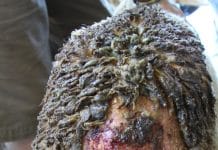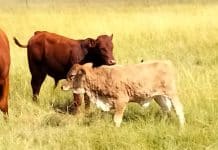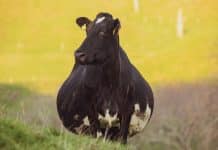
Estimated reading time: 7 minutes
Giving ewes flush feed prior to placing them with the rams has a proven positive influence on the conception rate of the particular flock. This is according to Dr Johan van Rooyen of the Steynsburg Animal Hospital in the Eastern Cape.
Ewes recording an increase in bodyweight prior to mating, he explains, have a better chance of conceiving. Depending on existing nutrient deficiencies, the advantage that flush feeding offers can be as much as a 20% increase in lambing percentage, though a 5 to 10% improvement is typical.
The purpose of flush feed
Hannes Beukes, a dairy and sheep nutrition specialist at Nova Feeds in Malmesbury, says flush feeding ewes is most effective around 17 days prior to mating until the rams are added. The aim is to increase ewes’ ovulation rate. However, caution should be exercised to keep ewes from becoming overly fat.
The first objective with flush feeding, he says, is to achieve growth of around 100g/day. A second objective in young ewes is to have them reach 80% of their mature weight at ten months of age, which gives them a fair chance of adapting to an intensive system.
According to André Fourie of Anker Agri, when planning the mating season, producers need to give due consideration to the fact that ovum development only takes place six months prior to the breeding season. The first step in preparing the ewes is thus to make sure their condition is acceptable.
“Trials conducted by the late Dr Jasper Coetzee,” he says, “revealed ewes that produced only one lamb the previous year could deliver up to 10% more lambs if given flush feed in the new year. In a 100-ewe flock, this amounts to ten more lambs. On the other hand, this percentage increases to 26 in ewes that had twins the previous year and which were given flush feed in the new year.”
Flush feed management
Producers will reap the rewards if they keep thorough records of their single and multiple lamb ewes, and flush feed them in separate groups in order to apply two different nutrition programmes. Do not neglect your twin-lamb flock; however, your single-lamb flock can be given slightly less flush feed as these ewes generate 16% less profit.
“Depending on the conditions in your region and on your farm,” he says, “and depending on whether it is a single- or multiple-lamb flock, the flush feeding programme needs to be adapted to stimulate optimal ovum development. This can amount to anything from 100 to 500g of lick per day. Some producers even argue that putting their ewes on a total mixed ration will play in their favour if grazing is scarce. For the best results, consult your nutritionist.”

When flushing your ewes, make sure there are no rams close by, warns André. If rams are present, it will stimulate oestrus in ewes, which means that by the time the breeding season arrives, some ewes may already have entered their third or fourth cycle or may already have entered anoestrus.
Kenneth Botha, technical director at Barnlab and co-owner of ARGOS farm, says the ‘wrong’ type of flush feed ration can be harmful to ewes. Correct composition is therefore crucial. There are far too many producers who invest in the wrong nutrition for these animals, culminating in lower lambing percentages.
For example, if only substandard veld grazing is available, you typically need to add a production lick (containing more energy, protein, bypass protein, minerals and vitamins). If animals run on good veld or green pastures, a ration containing moderate levels of nutrients will suffice. Good grazing contributes to energy and weight change. For this reason, ewes should be kept off substandard pastures during the flushing and breeding stage.
The exact composition of the flush feed ration will therefore depend on the on-farm resources at your disposal.
Guidelines for giving flush feed
One recommendation, says Dr Van Rooyen, is to manage ewe nutrition during the first 17 days prior to mating in a way that promotes at least a 5% (3kg on a 60kg ewe) weight gain and to maintain this increase until 17 days after mating.
Before giving flush feed, he explains, a number of actions must be taken to ensure that each ewe is optimally prepared and ready to conceive. The first step is examining the condition of the ewes at least 30 days before the breeding season, scoring each ewe and placing them in groups. Ewes that have a condition score below 3 must be given supplementary feed at once.
The second step is making sure ewes are not vitamin and mineral (e.g. vitamin A, phosphate or magnesium) deficient – this needs to happen 21 days prior to mating. Deficiencies can be remedied by using various commercial supplement blends.
Overly fat ewes will not respond to flush feeding. At times it is necessary to move ewes post-wean to camps that have a lower nutritional value and to move them back for a three-week period before mating. Some ten to 15 ewes are marked in each management group and weighed roughly three weeks before mating. The level of nutrition is then increased to support weight gain in ewes, but without compromising nutrient status.
There are different ways of flushing ewes, says Dr Van Rooyen. The first and best practice under extensive conditions is moving ewes to spare camps. Alternatively, ewes can receive a total mixed ration as supplementary feed at between 200 and 500g/day/ewe. Do not add urea to these rations.
A third option is giving ewes a production or protein lick (depending on the time of year). In summer, a phosphate lick may be sufficient, but there are limitations to this practice. High salt intake can be counterproductive, and many animals simply avoid eating the lick.
Water is essential
A fourth option is feeding chocolate maize at 50 to 100g/day, and to double the ration every seven days depending on weight gain. This option requires no feed troughs. If lupins are available, it can be used on a similar basis as chocolate maize, with excellent results.
The quality and quantity of water for the ewes is essential and can have a sizable influence on conception and lambing percentage.
After seven days, the ewes are remeasured at the same time each day, and the average weight increase or decrease is calculated so as to make the necessary nutritional corrections. To eliminate unnecessary variation in rumen content, the ewes can be left in the kraal for some time before weighing them.
The average weight of each group is recorded and the data entered on a computer spreadsheet. This allows for a graph to be compiled indicating the past year’s flush feeding, with the final weaning percentage included.
The effect on your profit margin
Dr Van Rooyen emphasises that correct flush feeding can significantly increase lamb yields and lead to higher profits. He calculates the profit from flush feeding by calculating the value of the newborn lamb using the present value, and then subtracting the production cost. The profit generated through flush feeding can be as much as 200%.
Read more about caring for ewes and lambs during lambing.
In one experiment, ewes were divided into three groups. Flock 1 received flush feed at 3kg/ewe, 21 days before mating. Flock 1 produced 10% more lambs than the control group. Flock 2 received flush feed during mating and produced 5% more lambs than the control group. Flock 3 was not given any flush feed. The groups were rotated weekly to reduce the camp’s effect.
Lambs’ value at birth was determined at R250 and the cost of feed was R4 per ewe. Total expenditure per ewe was therefore R12 and the added income was R25 (10% of R250) per ewe. Of course, the cost of labour and transportation must also be considered. However, the long-term positive effect of increased reproduction remains much greater. – Izak Hofmeyr, Stockfarm
For more information, contact Dr Johan van Rooyen of Steynsburg Animal Hospital on 087 551 278.





